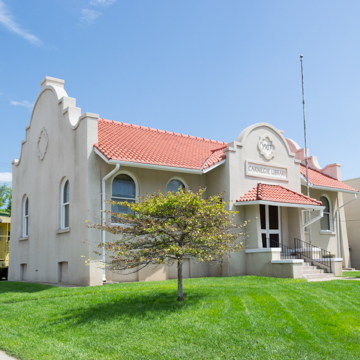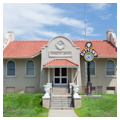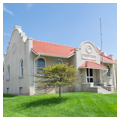The McCook Carnegie Library is designed in the Spanish Colonial Revival style that was rarely used for libraries in Nebraska. In this instance, local tradition holds that Coronado’s expedition passed nearby and this may explain the Spanish influence. Willis A. Marean of Denver, Colorado, designed the library, which is believed to be his only work in Nebraska.
The building is a one-story, rectangular structure over a raised basement. All four facades are strictly symmetrical. The library has smooth, white, plastered exterior walls and a low-pitched gable roof covered with red clay tiles. Each of the side gables and the prominent central entry pavilion are capped with a curvilinear parapet embracing a decorative quatrefoil. Other details include arched window openings and slightly tapered side gables extending beyond the front and rear elevations and two tapered buttresses on the rear elevation.
The McCook collection was originally housed in the county courthouse until its size exceeded available storage capacity. McCook County received a grant for the library from the Carnegie Corporation in 1905. In 1911 the Carnegie Corporation published a leaflet with design guidelines to aid communities and architects in library projects. Those guidelines included the need for simplicity accompanied by minimal decoration. Marean’s design for the library predated the stipulation that library designs were to receive approval and instead reflects his own aesthetic and functional preferences.
The building served as the McCook Carnegie Library until 1969. Today it is part of the Museum of the High Plains administered by the High Plains Historical Society.
References
Dollase, Mark, “McCook Public (Carnegie) Library,” Red Willow County, Nebraska. National Register of Historic Places Inventory–Nomination Form, 1985. National Park Service, U.S. Department of the Interior, Washington, DC.




